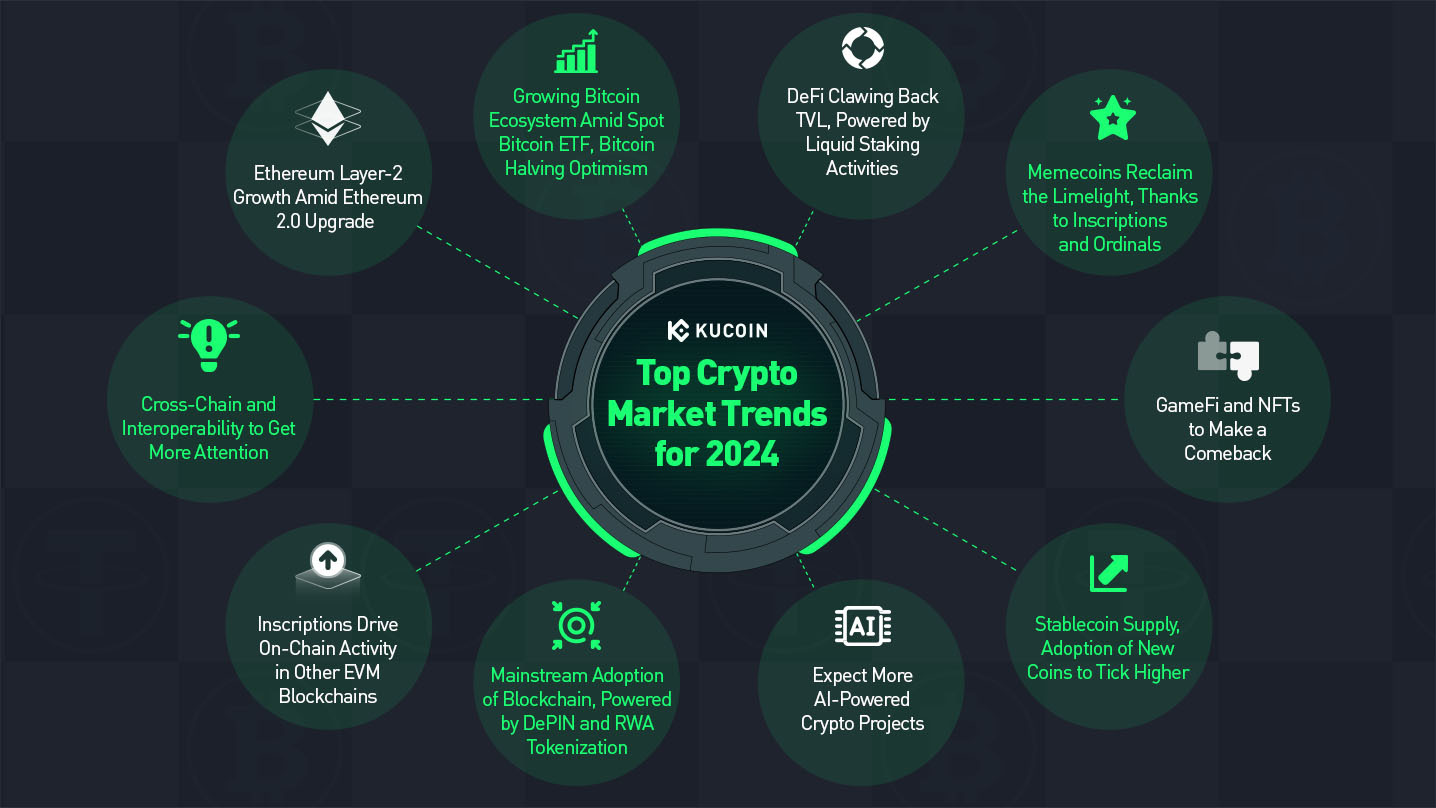Crypto Market Trends to Watch in 2024

- The Rise of Decentralized Finance (DeFi)
- NFTs: The Future of Digital Collectibles
- Regulatory Developments in the Crypto Space
- The Emergence of Central Bank Digital Currencies (CBDCs)
- The Impact of Institutional Investors on Crypto Markets
- The Role of Blockchain Technology in Supply Chain Management
The Rise of Decentralized Finance (DeFi)
The rise of decentralized finance (DeFi) is one of the most significant trends to watch in the crypto market in 2024. DeFi refers to a financial system that operates without traditional intermediaries such as banks or brokerages. Instead, it relies on smart contracts and blockchain technology to provide financial services directly to users.
DeFi has gained popularity in recent years due to its potential to democratize finance and provide greater access to financial services for people around the world. By eliminating the need for intermediaries, DeFi platforms can offer lower fees, faster transactions, and greater transparency compared to traditional financial institutions.
One of the key features of DeFi is its ability to enable users to earn passive income through various decentralized applications (dApps). These dApps allow users to lend their cryptocurrencies, provide liquidity to decentralized exchanges, and participate in yield farming to earn rewards.
As DeFi continues to grow, it is likely to attract more users and investment capital, leading to further innovation and development in the space. However, it also faces challenges such as regulatory scrutiny, security vulnerabilities, and scalability issues that will need to be addressed to ensure its long-term success.
NFTs: The Future of Digital Collectibles
NFTs, or non-fungible tokens, are gaining traction as the future of digital collectibles in the crypto market. These unique digital assets are revolutionizing the way we buy, sell, and trade collectibles online. NFTs are built on blockchain technology, making them secure and transparent. They allow creators to tokenize their work, providing proof of ownership and authenticity.
Regulatory Developments in the Crypto Space
Regulatory developments in the crypto space are expected to play a significant role in shaping the trends of 2024. Governments around the world are increasingly focusing on creating regulatory frameworks to govern the use of cryptocurrencies and blockchain technology. This increased regulatory scrutiny is likely to have a profound impact on the crypto market, influencing investor sentiment and market dynamics.
One key trend to watch in 2024 is the growing trend of regulatory clarity in major crypto markets. Countries such as the United States, the United Kingdom, and Japan are expected to provide more guidance on how cryptocurrencies should be regulated, which could help to reduce uncertainty and encourage greater institutional participation in the market.
Another important development to monitor is the rise of central bank digital currencies (CBDCs). Several countries, including China and Sweden, are already in the process of developing their own digital currencies, which could potentially challenge the dominance of existing cryptocurrencies. The introduction of CBDCs could also lead to increased regulatory oversight of the crypto market as governments seek to protect their monetary sovereignty.
The Emergence of Central Bank Digital Currencies (CBDCs)
The emergence of Central Bank Digital Currencies (CBDCs) is a significant trend to watch in the crypto market in 2024. CBDCs are digital forms of fiat currencies issued by central banks. These digital currencies are gaining traction as governments and financial institutions explore the potential benefits of digitizing traditional currencies.
CBDCs offer several advantages, including increased efficiency in payment systems, reduced transaction costs, and enhanced financial inclusion. Central banks around the world are conducting research and pilot programs to assess the feasibility of launching their own CBDCs. Countries like China, Sweden, and the Bahamas have already made significant progress in developing and testing CBDCs.
As CBDCs continue to gain momentum, they are expected to have a profound impact on the crypto market. These digital currencies could bridge the gap between traditional finance and the crypto space, potentially leading to increased adoption of cryptocurrencies. Additionally, CBDCs could provide a regulatory framework for digital assets, addressing concerns around security, privacy, and compliance.
The Impact of Institutional Investors on Crypto Markets
One of the key trends to watch in the crypto market in 2024 is the impact of institutional investors. Institutional investors, such as hedge funds, pension funds, and asset management firms, have been increasingly entering the crypto market in recent years. This influx of institutional money has the potential to significantly influence the direction of crypto markets.
**Institutional investors** bring with them large amounts of capital, which can lead to increased liquidity and price stability in the crypto markets. Their participation can also bring a level of legitimacy to the industry, attracting more traditional investors who may have been hesitant to enter the market in the past.
However, the presence of institutional investors can also introduce new challenges to the crypto market. Their large trades have the potential to cause significant price fluctuations, leading to increased volatility. Additionally, their investment strategies may differ from those of retail investors, which could impact market dynamics in unforeseen ways.
Overall, the growing involvement of institutional investors in the crypto market is a trend that is likely to shape the industry in the coming years. Keeping an eye on how these investors navigate the market and the impact they have on prices and overall market sentiment will be crucial for anyone looking to stay informed about crypto market trends in 2024.
The Role of Blockchain Technology in Supply Chain Management
Blockchain technology is playing an increasingly important role in supply chain management, revolutionizing the way businesses track and manage their products. By utilizing blockchain, companies can create a secure and transparent record of transactions that is accessible to all parties involved in the supply chain. This technology allows for greater visibility and traceability, reducing the risk of fraud and errors.
One of the key benefits of blockchain in supply chain management is its ability to create a decentralized ledger that cannot be altered or tampered with. This ensures that all transactions are secure and immutable, providing a high level of trust among participants. Additionally, blockchain technology can streamline processes, reduce costs, and improve efficiency by eliminating the need for intermediaries.
With the increasing globalization of supply chains, blockchain technology offers a solution to the challenges of managing complex networks of suppliers, manufacturers, and distributors. By providing a single source of truth that is accessible to all parties, blockchain can help to reduce delays, disputes, and inefficiencies in the supply chain.






